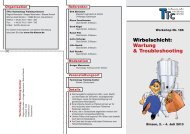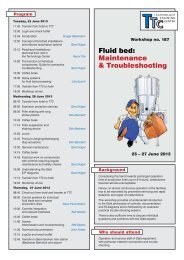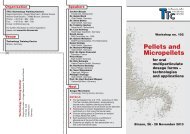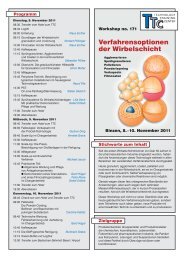PARTICLE COATING - TTC Technology Training Center
PARTICLE COATING - TTC Technology Training Center
PARTICLE COATING - TTC Technology Training Center
Create successful ePaper yourself
Turn your PDF publications into a flip-book with our unique Google optimized e-Paper software.
<strong>PARTICLE</strong> <strong>COATING</strong>:<br />
NUTRACEUTICALS AND PROBIOTICS<br />
Glatt <strong>TTC</strong> Workshop<br />
Binzen, Germany<br />
June 26-28, 2002<br />
PREAMBLE<br />
The industry workshop, the fifty-third in the Glatt series, attracted fifty participants,<br />
predominantly from industry, including both users and producers of materials and technologies<br />
for the food and life science industries. Attendees from Europe, the Americas, Africa, Asia and<br />
Australia included academics and representatives from SMEs. The Workshop included<br />
seventeen presentations related to markets, materials and technology, with a practical session<br />
demonstrating granulation, hot melt coating, pellet coating and microcapsule production. The<br />
workshop, which focused on food applications, was held in the Black Forest, just north of Basel.<br />
The networking opportunities were interspersed with some excellent local cuisine as well as a<br />
wine-tasting evening, particularly a variety of reds made from grapes harvested from vines which<br />
are over one hundred years old.<br />
GENERAL OVERVIEW<br />
Gabrie Meesters (DSM, The Netherlands): Trends in the Food and Life Science<br />
Industry There are two parallel trends, one in which consumers now spend less time cooking per<br />
day, down to an average of 20 minutes, from 90 minutes fifty years ago. Given this, the<br />
chemical industry sees an opportunity for higher margins in life and food sciences and is<br />
transforming itself into a service provider. The food market is $2.8 trillion per year, with<br />
another trillion not passing through supermarkets. Half of this market is the US and EU, with a<br />
total of 25% of world food consumption on processed “food services”. Only 17% of food<br />
consumption is in Asia, with the majority of “demand” in the raw ingredient category.<br />
However, in the developing world there is a demand for prenatal and infant nutrition, given the<br />
birthrate. The ingredient producers include Kerry Group, CSM, Roche, DSM, Rhodia, CP Kelco.<br />
They sell to manufacturers such as Best Foods, Nestlé, Philip Morris, PepsiCo, Coca Cola, Mars<br />
and Dannon. The top 10 ingredient and food manufacturers have 32% and 18% of the market.<br />
The manufacturers sell to retailers, of which the largest is Walmart ($152B per annum), at times<br />
passing through blenders. The food market also sees many synergies between businesses with<br />
very different products designed to provide a fast or convenient service, including the gasoline<br />
stations which now sell hot meals which can be purchased close to the home.<br />
Meesters notes that there is an increasing demand for innovative ingredients. This<br />
requires technologies which adapt to regional or national markets. Another important driver for<br />
food development is the aging of the population. These demands require supply chain exchange<br />
of information related to application know-how. Other tendencies include the concentration of<br />
retails and the movement of food service providers into the retail market. Ingredient<br />
manufacturers and food manufacturers are also merging, within their respective domains, with<br />
the dietary supplement market expanding rapidly.<br />
Food safety and hygiene is changing the structure of the food market, with meat<br />
replacers increasing rapidly in sales. Issues for the consumers include the consumption of<br />
hormones, genetically modified seeds as well as disease transmission. Food safety also impacts<br />
on equipment (e.g. spray dryer) design and operation, with the need to consider the frequency of<br />
cleaning as well as if wet or dry cleaning will be employed, both of which offer disadvantages.<br />
Engineers must also consider that the selling price of coated enzymes, for example, is 100-1000<br />
times lower than pharmaceuticals, though the demands for high quality, consistent, coated<br />
materials, or pellets, remain constraints. This, therefore, requires combined technical solutions<br />
including spray and fluidized bed drying with feed-foreword/feed-back control. Particle<br />
specifications include density, strength, shape, moisture content and stability, both on average as<br />
well as the distribution of these statistics within and between batches.<br />
1 of 5
PRODUCT DEVELOPMENT AND DESIGN<br />
Tage Affertsholt (3A Business Consulting, Denmark): EU Health Claim Regulations<br />
The EU defines a medicinal product as a substance or combination of substances<br />
presented for treating or preventing disease in humans or animals, or restoring, correcting or<br />
modifying physiological functions. Spurred by various national agencies related to food and<br />
health, often regulated by different agencies, the EU is now discussing norms for labeling.<br />
There are also proposals for directives on food supplements and fortified foods, both submitted<br />
in mid 2000. Pan-European claims should come into force in mid 2004.<br />
The EU commissioner for Health and Consumer Protection, David Byrne, recently stated<br />
that the “prevention of a disease and (the) reduction of the risk factors of a disease are clearly<br />
not the same, and we must be careful to avoid such confusion. Therefore, the development of<br />
“biomarkers”, or indicators, which are both validated and predictive, as cholesterol and blood<br />
pressure are for cardiovascular diseases. The use of these markers is expected to increase the<br />
growth rate of functional foods and nutraceuticals, up to 10-20% per annum.<br />
Claude Champagne (Agriculture Canada, Quebec): Challenges in the use of Coated<br />
and Non-Coated Cultures in the Development of Foods Containing Probiotics<br />
Probiotics are live microbial supplements, which beneficially affect the host by<br />
improving the intestinal microbial balance. Benefits include facilitated digestion, a lower<br />
incidence of diarrhea, lower cholesterol levels and incidents of colon cancer, as well as an<br />
increase in the non-specific host resistance to pathogens. In the US, 60% of yogurts now<br />
contain probiotic cultures.<br />
Champagne reduced the development of functional foods into seven challenges:<br />
1. Choice of strain<br />
• In addition to cost and quality, religious influences are becoming increasingly more<br />
important. Most strains are, for example, Kosher. Furthermore, the stability in dry and<br />
frozen form is also an issue, as is stability in acidic conditions and compatibility with<br />
other cultures and growth in milk. Oxygen tolerance for growth is almost always<br />
important.<br />
2. Concentration of the active ingredient<br />
• There is a need for clinical data, along with an appreciation that there are significant<br />
differences between people. Dosages vary from 10 6 to 10 9 CFU/mL.<br />
1. Toxicity<br />
• The issues of overdose, particularly in non-healthy individuals, are issues to resolve.<br />
2. Incorporation into food<br />
• The concentration after cold storage for long periods does not always correlate with the<br />
initial level, implying that detailed studies are needed to select strains. Probiotics are also<br />
quite sensitive to sugar level.<br />
• To help the probiotics survive, in cheese for example, higher temperature coagulation of<br />
cheddar and gouda has been advocated.<br />
• Entrapment of culture in polysaccharides can significantly increase strain survival during<br />
frozen storage. Cryoprotectants, such as mannitol and glycerol, within the bead, also<br />
promote survival. Furthermore, beads of 30 micrometers or larger result in longer<br />
probiotic survival.<br />
3. Active component analysis<br />
• Some strains are not easy to detect with typical analytical methods.<br />
4. Storage stability<br />
• Some fruits and extracts can kill the probiotic population.<br />
• Lipid coating can improve stability.<br />
5. Effect on sensory properties<br />
• Examples of advantages include the reduction of undesirable side-flavors..<br />
• Alginate beads can liberate some off-flavors.<br />
2
Denis Poncelet (ENITIAA, Nantes, France): Methods for the Encapsulation of<br />
Nutraceuticals<br />
Poncelet, the president of the Bioencapsulation Research Group, compared<br />
immobilization methods for nutraceuticals. Spray-based methods include spray drying, jetcutting<br />
and centrifugal extrusion. These compete with emulsion-based coacervation<br />
technologies, film coating via fluidized beds or pan coating, and multi-lamellar vesicles. Film<br />
coating, which remains relatively uncommon, has the advantage of permitting room temperature<br />
processing. For large-scale applications, the static mixers are able to produce emulsions on the<br />
order of seconds, versus minutes for emulsions agitated mechanically. These techniques, which<br />
do not produce monodisperse spheres, can produce ton-sized quantities, as opposed to gram-tokilogram<br />
levels for the balance of the methods.<br />
David Hunkeler (AQUA+TECH, Switzerland): New Materials and Characterization<br />
Methods<br />
Encapsulation and coating materials differ in price by seven orders of magnitude, with<br />
the value derived by the extent of purification as well as the retailing of batches proven for given<br />
applications. Hunkeler’s second theme was the extreme sensitivity of microbead and<br />
microcapsule properties to very minor changes in process conditions (e.g. reaction time, buffer<br />
concentrations). Microcapsule mechanical properties were also shown to correlate with<br />
membrane volume, with permeability decoupled via the use of coatings. Therefore, the control of<br />
capsule quality (e.g. size and permeability distributions within and between batches) by advances<br />
in downstream processing and the application of oligocations is an important in moving toward<br />
reproducible up-scaled sterile systems. Overall, Hunkeler predicted a market opportunity for the<br />
retailing of marine polysaccharides with specific properties (e.g. endotoxin and protein levels,<br />
microstructure, viscosity) and guaranteed application efficacy. The later would include batches<br />
tested and proven for applications in food, pharma/biotech and clinical transplantation.<br />
EXCIPIENTS<br />
Jörg Brunemann (Syntapharm, Germany): The Most Popular Excipients for Spray<br />
Coating Film coating with carbohydrates, lipids, proteins, terpenes (e.g. shellac) and pigments<br />
was reviewed. Typically, spray coating on nutraceuticals utilizes cellulose ethers which have the<br />
advantage of solubility in cold water. However, the film elasticity, at least in the case of methyl<br />
cellulose, requires the addition of a plasticizer such as stearic acid. Interestingly, elasticity tends<br />
to correlate with stickiness.<br />
“Biogums” such as Gum Arabic are very low viscosity polysaccharides which render it<br />
suitable as a coating agent. The biogums, including xanthan, Guar gum and Locust Bean gum<br />
all dissolve, or disperse, well in cold water and are good thickeners, where they function better<br />
than as coating agents. Lipids are used for moisture protection and are sprayable at<br />
temperatures as low as 30 o C. In contrast, waxes, such as Carnauba, have a polishing effect and<br />
a higher melting point. Shellac, provides very dense films and is excellent for taste and odor<br />
masking as well as humidity protection. Shellac’s main disadvantage is a loss of solubility of<br />
the coating with storage if sprayed with alcohol, though it is now available in aqueous solutions,<br />
solubilized with ammonium carbonate.<br />
Ian Marison (Swiss Federal Institute of <strong>Technology</strong>): Excipients for Liquid<br />
Encapsulation<br />
“Liquid Core” capsules have been applied in medical, pharmaceutical, food and<br />
bioconversion applications. Excipients include polyelectrolytes of natural and synthetic origin,<br />
crosslinked polymers as well as those gelling thermally (e.g. collagen) or photopolymerizing.<br />
An innovative modification to the standard microcapsule chemistry involved the treatment of<br />
alginate-poly-L-lysine capsules with sodium hydroxide. The resulting dense membrane had<br />
improved durability. Marison, in association with Inotech, encapsulated yeast cells and showed<br />
that the solvent does not influence the cells, with the capsules stable in the fermenter. He also<br />
revealed that autoclaved capsules are smaller and much weaker than the non-purified parents.<br />
3
Frank Runge (BASF Fine Chemicals, Germany): Formulation of Nutraceuticals for the<br />
Food and Supplement Industry<br />
Micronutrients as food supplements include vitamins, both water- and fat-soluble,<br />
Carotenoids as well as nutraceuticals, such as Omega-3 fatty acids and lycopene. BASF is<br />
preparing oil-in-water emulsions containing 1-micrometer droplets as a means of encapsulation.<br />
Spray agglomeration is preferred to spray drying or spray-formulation/cooling, though the latter<br />
results in solid “beadlets” of 200 micrometers in diameter. Spray-formulation is carried out at<br />
lower temperatures (less than 70 o C) which are misted through the top of a fluidized bed tower<br />
and coated with a fine powder matrix. The stabilizer, typically gelatin, acts as a matrix and<br />
supports the micronutrients. It is subsequently coated in a starch or silica outer layer. The<br />
resulting core-shell beadlets are quite mechanically stable, even to tablet compression, also<br />
providing a good oxygen barrier. They can also have micronutrient loadings on the order of 25-<br />
75%. The BASF system is essentially the opposite of the Glatt coating, where an emulsion is<br />
coated onto a powder.<br />
Carotenoid nanoparticles are produced by milling, precipitation, intense emulsification or<br />
mixed micelle systems. The former two lead to solids. The precipitation process requires a<br />
dissolution of the Carotenoid in hot alcohol (200 o C) at high pressures (50 bars). This is mixed,<br />
rigorously, with a protective colloid, in a continuous process resulting in a precipitation<br />
generating a core of Carotenoid with a colloidal shell.<br />
For beverage applications, colloid stability is the key and the adsorption of emulsifiers,<br />
polymers or polyelectrolytes are common. The natural polyions, such as Gum Arabic or<br />
modified starch, provide the best stability, provided the high molar mass polymers are properly<br />
hydrated.<br />
Friedrich Heinze (National Starch/ICI, Germany): Functional Nutraceutical<br />
Carbohydrates<br />
At least 55%, and as much as 75%, of human energy need is derived from<br />
carbohydrates. The ideal nutritional scenario requires a variety of starches with different<br />
degradation rates in the small intestines and colon. The “resistant” starch intake has been<br />
shown to correlate well with lower incidence of colon cancer. However, EU consumption is<br />
currently at 4 grams per day, tenfold lower then is recommended, though vegetarians eat over 20<br />
g per day. Resistant starches come from unmilled whole grains, fruits, vegetables, green bananas<br />
as well as cooked potatoes. In addition to food supplement, resistant starch is envisioned for<br />
satiety and obesity control.<br />
Glycemic carbohydrates focus on the small intestine. They are used, for example, to increase the<br />
availability of carbohydrates and reduce the peak of the gycemic response following eating.<br />
They are also advocated as sports foods, reducing the pasta intake prior to very strenuous<br />
activities.<br />
PROCESS TECHNOLOGY<br />
Caroline Mähr (<strong>Technology</strong> Transfer <strong>Center</strong>, Bremerhaven, Germany): Encapsulation<br />
in Food <strong>Technology</strong><br />
The German food industry is characterized by SMEs with only 2.4% of the 6000 firms<br />
having more than 500 employees. The Food industry, the fourth largest German economic<br />
sector, has a growth of 1% per annum, despite quite extensive new product introduction. This is<br />
due, in part, to a reduction of disposable income allocated to nutrition, down from 22% in 1990<br />
to 15% a decade later. The <strong>Technology</strong> Transfer <strong>Center</strong> (TTZ) in Bremerhaven is a non-profit<br />
center geared to assisting these SMEs with product innovation. It has five institutes, one of<br />
which, BILB, is dedicated to food process and product development, including encapsulation.<br />
TTZ functions based on queries from firms, providing accelerated product or process<br />
development via an outsourced research development. They also identify partners, write<br />
proposals, and carry out the scientific and administrative co-ordination. At present TTZ<br />
participates in fifty European grants. Bremerhaven has also launched a Biocenter for food and<br />
biotech startups.<br />
4
Sebastian Pfûtze (Glatt, Germany): Continuous Fluid Bed Coating<br />
Spray granulation is a process where there is a solid incipient used as a starter onlyd,<br />
though their is a larger fraction of powders produced from the liquid itself. It can be contrasted<br />
with coating technology where the incipient always serves as a core. Spray granulation is<br />
preferred for sizes below above 200 micrometers. Typically, the viscosity at the particle has to<br />
be low for good spreading and an even coating. This implies a low solid concentration in the<br />
spray liquid. The final particles are sieved, with the smaller fractions recycled back to the inlet of<br />
the continuous bed. The oversized particles are milled, with, again the smaller fraction fed back.<br />
Importantly, all particles grow at the same rate, implying no change in the breadth of the particle<br />
size distribution with time.<br />
Pfûtze noted that agglomeration is lower for bottom (Wurster) spray fluidized beds than<br />
for top spray based systems. He also mentioned that there is very similar coating properties in<br />
batch and continuous fluidized beds. However, for the latter, the ratio of the mean mixing and<br />
residence times are important influences on the breadth of the particle size distribution.<br />
As an example of the productivity of the continuous beds, a 7.5 m 2 bottom bed area can<br />
produce 5 Tons per hour of product.<br />
Klaus Eichler (Glatt, Germany): Technological and Qualitative Evaluation of Bottom,<br />
Top and Tangential Spray Coating<br />
Eichler compared the advantages and disadvantages of the various spraying techniques.<br />
Key parameters include the spreadability of the droplet on the substrate as well as the ratio of the<br />
droplet to substrate size (must be much less than unity). The spreadability is extremely sensitive<br />
to the bed temperature.<br />
Top spray is a counter-current process, which results in an inhomogeneous coating. It is<br />
useful as a barrier coating, though perhaps not for taste masking. Top spray has the advantage<br />
of having the shortest processing times. Bottom spray prevents these handicaps by reducing the<br />
distance between the spray tip to the surface. This permits smaller spray droplets, whose size is<br />
governed by the air volume through the nozzle’s orifice. Wurster is the most reliable process,<br />
batch to batch, as well as having a very uniform droplet size distribution. The Wurster also has<br />
the advantage of being able to uniformly coat non-spherical, and highly irregular, particles.<br />
Tangential coating (rotating discs) are basically horizontal Wurster’s with essentially<br />
identical coating properties. This technology is usually used to add high quantities of coating<br />
material, up to 300-800% per hour. Its a dry powder coating which basically accumulates in a<br />
snowball effect by rolling up on the disk. However, it is less versatile than the Wurster and has<br />
a high risk for agglomeration.<br />
Muriel Jacquot (ENSIA, Nancy, France): Spray Coating of Enzymes<br />
Lactoperoxidase, thiocyanate and hydrogen peroxide, is a natural “LPS” system present<br />
in raw milk and is, therefore, advocated as an alternative to chemical preservatives for transport to<br />
the dairy. Jacquot is using LPS, in microbeads, to protect the surface of foods, such as fish.<br />
The bead includes a core of acacia gum with glucose, loaded with thiocyanate and spray dried.<br />
Enzymatic coatings are added via fluidized bed with bottom spray. This reduces the risk of<br />
allergy during handling of powders and the health risks associated with dusts. The encapsulated<br />
system had very good flow- and handle-abilities and showed less than 25% losses in activity<br />
over ten months, rendering it a low cost industrial alternative.<br />
David Hunkeler<br />
AQUA+TECH Specialties S.A.<br />
Route de St. Eloi, CH-1350 Orbe<br />
Switzerland<br />
david.hunkeler@aquaplustech.ch<br />
Klaus Eichler<br />
Glatt <strong>TTC</strong><br />
Binzen, Germany<br />
klaus.eichler@glatt.de<br />
5









